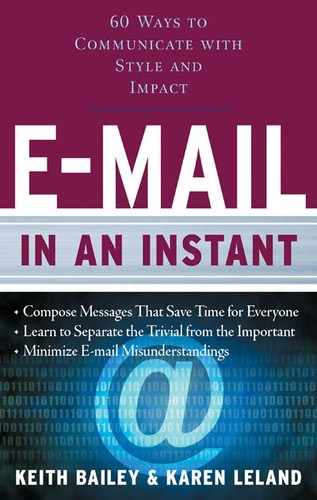6
Be Formal With Neutral Language
Much of the language used in business is non-sensory, or neutral. In other words, it does not provide any clue as to which type of sensory modality (visual, auditory, or feeling) the writer prefers. For example, a writer with a preference for visual words may say, “I can see what you mean.” An auditory response would be, “I hear what you are saying.” And so on. If you want to send an e-mail that has a high degree of formality, and sounds more official or legal, then use neutral language. Some of the most common neutral words used in business include:
Exercise
Consider the following facts and take a stab at crafting an e-mail in the space following, using only neutral language.
• Jim Smith ordered a dozen daiquiri-flavored doughnuts to be mailed overnight from your Website, www.deliciousdoughnutsareus.com.
• The doughnuts arrived on time, but were margarita-flavored, not daiquiri.
• Jim Smith is upset and has written an e-mail asking what happened.
• Your company is willing to ship the correct order overnight at no charge.
How did you do? Here’s one example of how neutral language might work in this situation.
______________________________________________________________________
______________________________________________________________________
Subject: Doughnut Debacle
From: Dan Davies
Date: October 15
To: Jim Smith
Dear Mr. Smith:
Our apologies for the mistake involving your recent daiquiri-flavored doughnut order. We believe this error occurred due to a computer glitch involving a sugarglazed doughnut with sprinkles and a spilled cup of coffee. We will do what we can to make this right. Please consider our offer to overnight the correct doughnuts to you, at our cost, as a formal apology for the mistake.
Yours truly,
Dan Davies
Head Doughnut Maker

